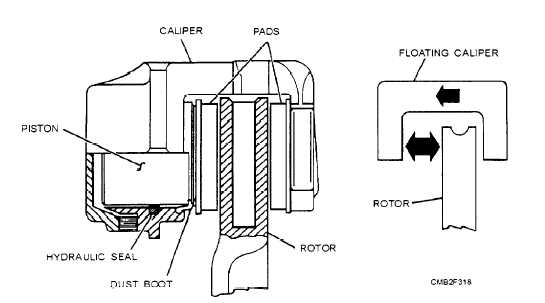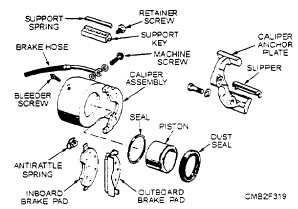
Figure 7-17. - Floating caliper.
Additional pressure then forces the caliper assembly to move in the opposite direction of the piston, thereby forcing the brake pad on the opposite side to contact the rotor.
As pressure is built up behind the piston, it forces the brake pads to tighten against the rotor. This action develops additional braking force.
SLIDING CALIPER TYPE. - The sliding caliper type disc brake (fig. 7-18) is mounted in a slot in the caliper adapter. It is a variation of the floating caliper, using a single piston and operating on the same principle, whereby the piston applies pressure to one brake pad and the movable caliper applies pressure to the other.
This design has two major sections - the sliding caliper and the caliper adapter (anchor plate). Each has two angular machined surfaces: this is where the sliding contacts come into play. The machined surfaces of the caliper housing slide on the mated surfaces of the caliper adapter when the brakes are applied.

Figure 7-18. - Sliding caliper.
FIXED CALIPER. - The fixed caliper disc brake (fig. 7-19) is rigidly mounted to the spindle or splash shield. In this design, the caliper usually is made in two pieces and has two or more pistons in use.
The pistons accomplish the centering action of the fixed caliper, as they move in their bores. If the lining should wear unevenly on one side of the caliper, the piston would take up the excess clearance simply by moving further out of the bore.
As the brakes are applied, fluid pressure enters the caliper on one side and is routed to the other through an internal passage or by an external tube connected to the opposite half of the caliper. As pressure is increased, the pistons force the brake pads against the rotor evenly, therefore maintaining an equal amount of pressure on both sides of the rotor.
BRAKE SWITCHES AND CONTROL VALVES
There are several types of switches and control valves used in hydraulic brake systems. Switches are normally safety devices. and there are two types used - the stoplight switch and the braking warning light switch. Control valves regulate pressure within the braking system, and there are three types - the metering valve, the proportioning valve. and the combination valve.
Continue Reading